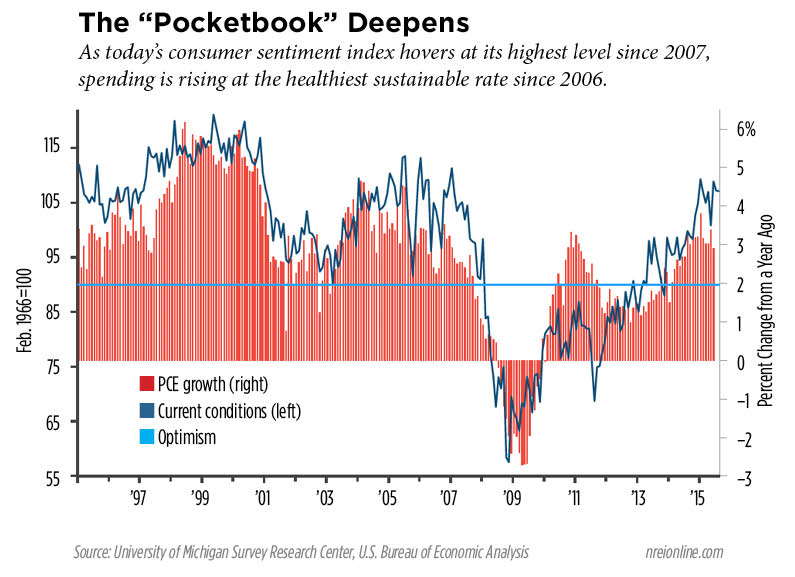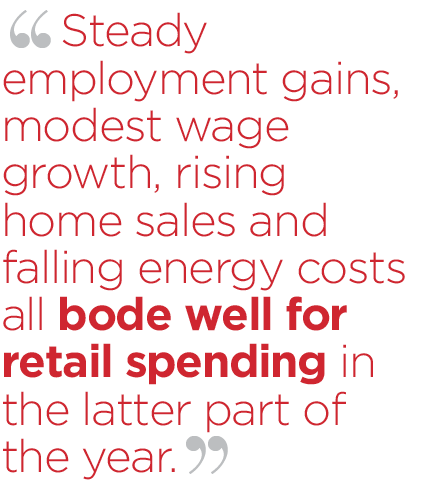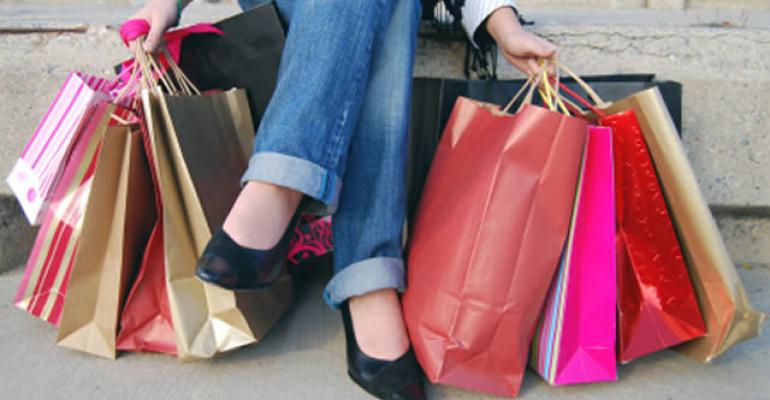American consumers are finally spending again, which is good news for retailers and retail property owners. The increased spending corresponds to improved consumer confidence, and experts expect that trend to continue.
A brand-new research note from Cushman & Wakefield, “The Consumer is Back to Pulling His Weight,” indicates that consumers are optimistic about their current situation. “Consumers are in a good place,” says Kenneth McCarthy, a senior managing director in the firm’s economic analysis and forecasting group. “They feel like they’re in good shape, and they’re spending money.”
McCarthy adds that consumer spending is rising at the healthiest sustained rate since 2006. “The persistence of high levels of optimism … points to continuing solid growth in consumer spending in 2015 and 2016,” he says.
Employment drives consumer confidence
Very simply, consumer confidence is based on employment, contends Peter Muoio, Ph.D., chief economist for Auction.com and managing director for Maximus Advisors. “For a year and a half, we’ve had sustained job growth, lower unemployment and glimmers of wage growth,” he says. “All that translates into a more confident consumer.”
In addition, Muoio points to lower energy costs as another contributor to consumer confidence. “Most households are benefiting from the decrease in oil prices … they’re spending less of their monthly budget on gas, and eventually that will trickle down into retail spending,” he explains. “All this puts the retail segment in the best position since the recession—and certainly better than anything we’ve seen in recent years.”
Both the University of Michigan’s Index of Consumer Sentiment and The Conference Board’s Consumer Confidence Index indicate that consumers are increasingly confident—quite a shift from the early days of the economic recovery.
During the first four years of the expansion, there was very little improvement in consumer confidence as measured by the University of Michigan’s Index of Consumer Sentiment. In October 2013, for example, the Index stood at 73.1—not much higher than the 70.1 reading recorded four years earlier in October 2009 just after the recession ended. Since October 2013, confidence has jumped sharply. Today’s reading of 92.9 is 26.9 percent above the level of October 2013.
When the University of Michigan surveys consumers for its index, it asks two kinds of questions: those related to the current situation (“Is your income higher than a year ago?” and “Do you think the economy is better today than a year ago?”) and those related to expectations about the future (“Do you expect your income to rise in the next 12 months?”).
Current conditions are the “pocketbook” issues and when this index is high, consumer spending is usually growing at a healthy pace. Today, the current conditions index is hovering near its highest level since 2007.

Meanwhile, the Conference Board’s Consumer Confidence Index now stands at 101.5 (1985=100), up from 91.0 in July. Conducted by Nielsen, the survey is based on a probability-design random sample. The Conference Board attributes the improved rating to a more favorable appraisal of the labor market, as Muoio suggests.
Muoio admits that the consumer confidence indices are not his “favorite stats” because they are based on surveys. He is a bigger fan of the Economic Policy Uncertainty Index, which measures the degree to which businesses and households are uncertain about the economy. Higher levels of uncertainty correlate with people holding back on expenditures.
 “In late 2012, we saw the Uncertainty Index began to ease down and the confidence indices go up,” Muoio says. “They feel more certain about making purchases, especially big purchases, because they feel confident they can make future payments.”
“In late 2012, we saw the Uncertainty Index began to ease down and the confidence indices go up,” Muoio says. “They feel more certain about making purchases, especially big purchases, because they feel confident they can make future payments.”
Consumers open wallets, finally
As might be expected, the consumer is the most critical driver of U.S. economic growth, accounting for approximately 68 percent of gross domestic product (GDP). When Americans save rather than spend, it impacts the economy, particularly the retail sector.
Recently, consumer spending has begun to grow more strongly. After increasing at an average annual rate of 1.9 percent in the first three years of the expansion, real consumer spending has expanded by 2.8 percent per year over the past year and a half, according to the U.S. Census Bureau.
This acceleration in spending has coincided with rising consumer confidence. McCarthy says consumers are much more optimistic today about the current situation than the future. “Basically, the attitude can be summed up as ‘I am a little worried about where things are going, but I am doing fine’,” he explains.
Throughout the current economic expansion, the U.S. consumer under-spent. In the 72 months since June 2009 when the expansion officially began, consumer spending, adjusted for inflation, has increased only 14 percent, or 2.2 percent per year, according to Cushman & Wakefield’s research. In the four previous economic expansions (which began in 1975, 1982, 1991 and 2001) consumer spending increased an average of 3.5 percent per year over the same 72-month period.
Cushman & Wakefield’s research note provides some context to the consumer spending under-performance: “If consumer spending growth in the current cycle matched the average of the preceding four expansions, U.S. GDP growth during the expansion would have averaged a very respectable 3 percent per year instead of the anemic 2.1 percent per-year growth the economy has actually recorded.”
Minimal risks to retail spending
Retail sales, adjusted for inflation, were up 4.8 percent from a year ago in July and sales at GAFO stores (general, apparel, furniture and other) have increased at an annual rate of 8.3 percent from the weather-induced February decline through June.
Experts contend that if consumer confidence remains high, it will lead to faster growth in consumer spending, and eventually will have a positive impact on retail real estate
“Steady employment gains, modest wage growth, rising home sales and falling energy costs all bode well for retail spending in the latter part of the year,” says John Chang, first vice president of research services for Marcus & Millichap.
Even the stock market volatility and Chinese currency devaluations aren’t a major concern at this moment. “Although stock market volatility and international risks, should they run longer than anticipated, could potentially weigh on short-term performance, retail spending will likely continue on its upward trajectory, with growth aligning with what has been generated in the last year,” Chang notes.

